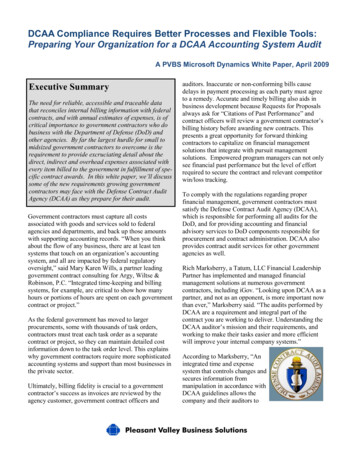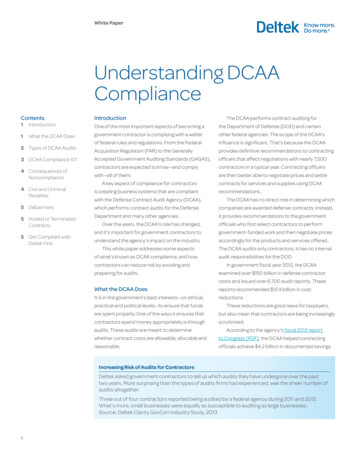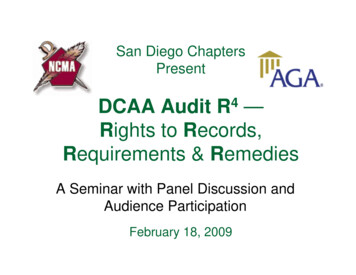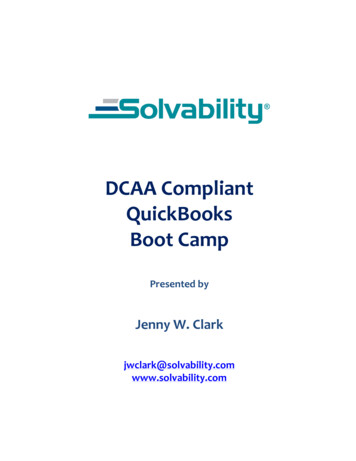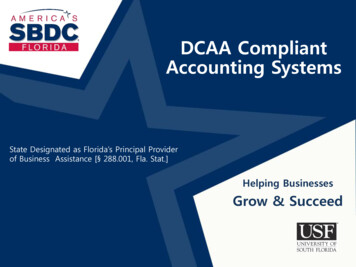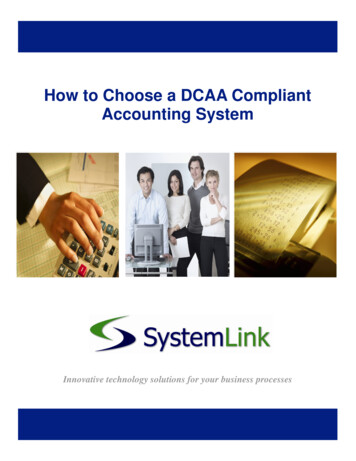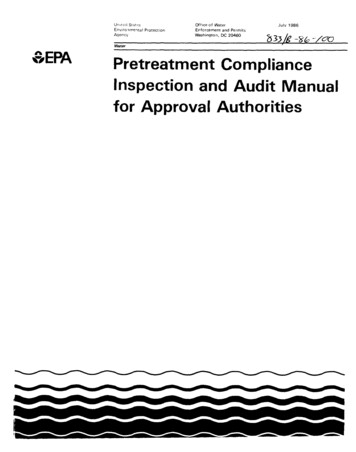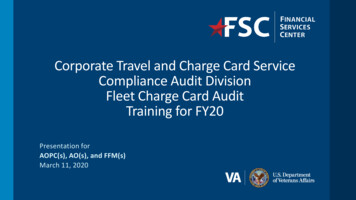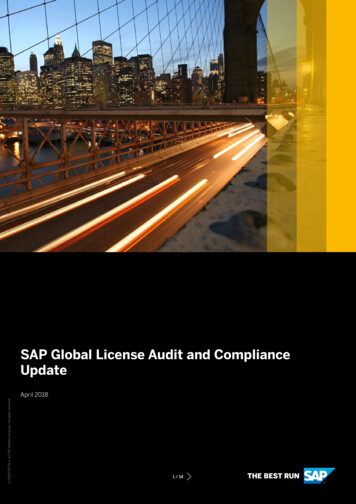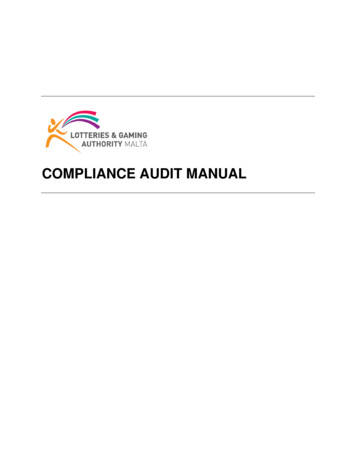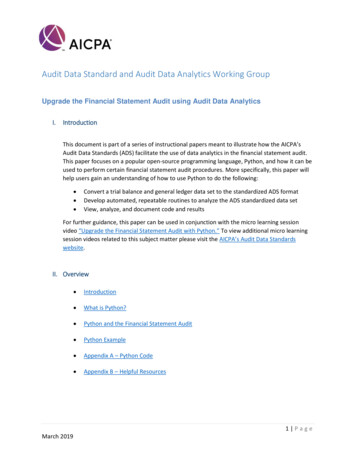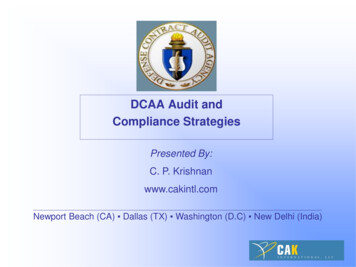
Transcription
DCAA Audit andCompliance StrategiesPresented By:C. P. Krishnanwww.cakintl.comNewport Beach (CA) Dallas (TX) Washington (D.C) New Delhi (India)
www.sba.gov
DCAA Audit & Compliance StrategiesWho is DCAA?The Defense Contract AuditAgency, operates under theauthority, direction, and controlof the Under Secretary ofDefense (Comptroller),(USD(C)) / Chief FinancialOfficer (CFO), Department ofDefense.www.cakintl.com
DCAA Audit & Compliance StrategiesGoverning RegulationsThe DCAA Contract Audit Manual (CAM) provides extensiveadditional information on audit policies and procedures. TheDCAA Pamphlet 7641.90, Information for Contractors;DCAAM 7640.1; CAM, and current audit guidance (notincorporated into CAM) are available on DCAA’s web site atwww.dcaa.mil. Other acquisition reference materials can befound on the Defense Acquisition University’s (DAU’s)Acquisition, Technology and Logistics’ Knowledge SharingSystem (AKSS) web site at http://akss.dau.mil.www.cakintl.com
DCAA Audit & Compliance StrategiesWhat Constitutes DCAA Compliance- Identifying and evaluating all activities that eithercontribute to or have an impact on proposed or incurredcosts of government contracts.-Financial Policies, Procedures, and Internal controls.- Identify opportunities to reduce or avoid costs.www.cakintl.com
DCAA Audit & Compliance StrategiesFAR Cost PrinciplesFAR Part 31 - A chronology that is used to determinethe cost principles in effect at time of contract awardthat may be necessary for audits of historical costs. Itcan be found at www.dcaa.milwww.cakintl.com
DCAA Audit & Compliance StrategiesAudit Emphasis(1) internal control systems & management policies,(2)(3)(4)(5)accuracy and reasonableness of cost representations,adequacy and reliability of records/accounting systems,financial capability, andcontractor compliance with contractual provisions such as CASand the Truth in Negotiations Act.The extent of DCAA's involvement is determined by the type ofcontract that will be awarded. Generally, most DCAA efforts on firmfixed price type contracts take place during the proposal stagerather than in the incurred cost stage. The reverse is true forflexibly priced contracts.www.cakintl.com
DCAA Audit & Compliance StrategiesDefining Cost StructuresDirect costs are defined in FAR 31.202 as any cost that can beidentified specifically with a particular final cost objective (e.g., acontract). An example would be labor specifically identified to thecontract, or materials purchased specifically for the contract.Indirect costs are defined in FAR 31.203 as any cost not directlyidentified with a single, final cost objective, but identified with two ormore final cost objectives or an intermediate cost objective.Overhead CostsCosts that are incurred for or that only benefit an identifiable unit oractivity of the contractor internal organization such as a engineeringdepartment are considered overhead costs. It is common to findseparate overhead pools for engineering, manufacturing, materialhandling, and for certain off-site activities.www.cakintl.com
DCAA Audit & Compliance StrategiesDefining Cost StructuresExamples of overhead pool costs are:- Department supervision- Training of department employees- Fringe benefits of department employeesG&A CostG&A expenses represent the cost of activities that are necessary tothe overall operation of the business as a whole, but for which adirect relationship to any particular cost objective cannot be shown.G&A includes the top management functions Typically, it includeshuman resources, accounting, public relations, contractadministration, legal, etc.www.cakintl.com
DCAA Audit & Compliance StrategiesDefining Cost StructuresFacilities Capital Cost of Money (cost of capital committedto facilities) is an imputed cost. It is allowable whether or notthe contract is otherwise subject to cost accountingstandards (CAS).Other Indirect Cost Pools- IRAD- Bids & Proposals- Manufacturing Overhead- Fringe Benefitswww.cakintl.com
DCAA Audit & Compliance StrategiesDefining Cost StructuresUnallowable ExpensesExpenses that are legitimate business expenses however arenot allowed on government contracts. Examples include:-GSA IFF Fees-Federal Taxes-Interest Expenses-Donations-Penalties & Fines-Employee MoraleUncompensated OvertimeIt the unpaid hours worked over the standard 40 hours for exemptFAR 52.237-10 requires that all hours worked are recordedwhether paid or not. This is necessary because labor costs andoverhead are affected by total hours worked.www.cakintl.com
DCAA Audit & Compliance StrategiesAccumulation of Direct & Indirect Costsa. Proper segregation of direct from indirect costs.DCAA will review the accounting system todetermine if direct costs are segregated fromindirect costs.Indirect costs are normally placed in an overheador general and administrative G&A) expense pooland allocated to contracts on some equitablebasis. Once these criteria are defined, they mustbe consistently applied.www.cakintl.com
DCAA Audit & Compliance StrategiesAccumulation of Costsb. Identification and accumulation of direct costs by contract.DCAA will determine if the accounting system can accumulatecosts by contract (commonly referred to as a job order costaccounting system).c. A logical and consistent method for the allocation of indirect coststo cost objectives. DCAA will determine if indirect costs areallocated to cost objectives based upon relative benefits received,or other equitable relationship. Fundamentally, this means that acost may not be allocated as an indirect cost to a final costobjective if other costs incurred for the same purpose have beenincluded as direct costs of that or any other cost objective.www.cakintl.com
DCAA Audit & Compliance StrategiesAccumulation of Costsd. Accumulation of costs under general ledger control. DCAA willdetermine if the job order cost accounting system can bereconciled with the general ledger, and that the companyaccounting system is controlled by the general ledger.e. A timekeeping system that identifies employees' labor bycost objectives. DCAA will determine whether a contractor'stimekeeping system has the ability to track employees' timespent on each work activity.www.cakintl.com
DCAA Audit & Compliance StrategiesAccumulation of Costsf. A labor distribution system that charges direct and indirectlabor to the appropriate cost objectives.Once an employee's time is segregated, the costs must beallocated to the appropriate cost objectives.g. Interim (at least monthly) determination of costs chargedto a contract through routine posting to books of account.DCAA will determine if the accounting system produces appropriatereports that show the results of charges to contracts. These reportsshould be produced at least monthly.www.cakintl.com
DCAA Audit & Compliance StrategiesAccumulation of Costsh. Exclusion from costs charged to Government contracts ofamounts that are not allowable pursuant to FAR Part 31 orother contract provisions.The FAR identifies some costs as expressly unallowable: e.g., baddebts, contingencies, donations, entertainment, etc and requiresthat they be excluded from proposals and billings. While thesecosts may be legitimate business expenses, they will not beaccepted by the U.S. Government as allowable contract costs. FAR42.709 authorizes contracting officers to assess a penalty if acontractor claims an expressly unallowable costwww.cakintl.com
DCAA Audit & Compliance StrategiesAccumulation of Costsi. Identification of costs by contract line item and units (as ifeach unit or line item was a separate contract) if required bythe proposed contract. Some contracts require that the costof certain items be readily identifiable. In such cases, DCAAwill review a contractor's accounting system to determine if acontractor can comply with such requirements.j. Segregation of pre-production costs from production costs.DCAA will review a contractor's accounting system todetermine that the costs can be identified in this manner.www.cakintl.com
DCAA Audit & Compliance StrategiesAccounting System & Labor EvaluationsPre-award Surveys of Contractor Accounting Systems-Financial capability audits are performed to determine if thecontractor is financially capable of performing on Governmentcontracts. Reports including financial statements, lendinginstitutions, SEC filings, cash flow forecasts, loan agreements,aging of accounts receivable and payable, financial history of thecontractor and affiliated concerns, and payroll tax returns.The pre-award accounting system survey is to determinethe acceptability of the accounting system for accumulating costsunder a Government contract.www.cakintl.com
DCAA Audit & Compliance StrategiesQuickBooks Setup BasicsCompliant Chart of Accounts- Standard Balance Sheet Accounts- COGS (tracking direct costs, project related)- Most common indirect cost pools- Fringe (use all productive labor as the base)- Overhead (use direct labor as base)- General & Administrative (use total cost input as base)- Unallowable Costs (FAR Part 31.205)Indirect Costs – Approved Structure from DCAA is aminimum of 3 Rate Structure – Fringe, Overhead, and G&Apool. The G&A Pool can be further divided into sub pools –Facilities, Sales & Marketing, Finance & Admin, Bids &Proposal, Independent Research & Development.www.cakintl.com
DCAA Audit & Compliance StrategiesQuickBooks Setup BasicsDirect Cost ItemsAll Items in this list will map to the Cost of Good Sold account.Hence the Items will match the COGS accounts.Customers/Jobs are created using a Project Code Legend. Use asequential system to track jobs in QuickBooks. For example:1st Digit Procurement type2nd Digit Customer Code3rd & 4th Digits Contract awards within customer5th thru 7th Digits Subtaskwww.cakintl.com
DCAA Audit & Compliance StrategiesQuickBooks Setup BasicsPayroll ItemsAll Wages will be setup as Hourly Wages for DCAA purposes.Payroll Items will need to be setup for Direct, Overhead, and allG&A wages categories. Uncompensated Wages will also be setupunder both Overhead and G&A categoriesEmployee Setup will involve assigning employee wages to specificpayroll item accounts. Payroll Items are mapped to GL accounts.**QuickBooks is not a DCAA Approved Compliant System.However the correct setup of the system can derive acceptablereporting for DCAA.www.cakintl.com
DCAA Audit & Compliance StrategiesQuickBooks Setup BasicsJob Cost Ledger & General LedgerThese reports can be extracted from QuickBooks Reportmenu – Click on Profit & Loss by Job, and General Ledgerunder Accountant & Taxes.www.cakintl.com
DCAA Audit & Compliance StrategiesReview Accuracy-Profit & Loss should tie to Job Cost Ledger-Profit & Loss should tie to the Payroll Summary total-Payroll summary should tie to the Time by Name report-Vacation payroll Item should be set up to accrue on theBalance Sheetwww.cakintl.com
DCAA Audit & Compliance StrategiesAccounting System & Labor EvaluationsLabor Charging SystemTimekeeping procedures and controls on labor charges are areasof utmost concern. Unlike other costs, labor is not supported byexternal documentation or physical evidence to provide anindependent check or balance. It is critical to labor charging internalcontrol systems that the management indoctrinates employees ontheir independent responsibility for accurately recording timecharges.- Segregation of Responsibilities- Procedures- Maintenance of Controls- Employee Awarenesswww.cakintl.com
DCAA Audit & Compliance StrategiesAccounting System & Labor EvaluationsTime Card ComplianceDetailed instructions for timecard preparation should beestablished through a timekeeping company procedure.- Recording his/her time on a daily basis.- Recording time on the timecard in ink.- The correct distribution of time by project numbers, contractnumber or name for a particular assignment.- Changes to the timecard should be lined through, with theemployee's initials beside the change.- Recording all hours worked whether they are paid or not.This is necessary because labor costs and overheads are affectedby total hours worked, not just paid hours worked. Unpaid hoursworked are termed "uncompensated overtime."www.cakintl.com
DCAA Audit & Compliance StrategiesAccounting System & Labor EvaluationsTime Card Compliance- Signing the timecard at the end of each work period.- The supervisor should approve and cosign all timecards.- The supervisor is prohibited from completing an employee'stimecard unless the employee is absent for a prolonged period oftime on some form of authorized leave.- The guidance should state that the nature of the work determinesthe proper distribution of time, not availability of funding, type ofcontract, or other factors.- The company policy should state that the accurate and completepreparation of timecards is a part of the employee's job.www.cakintl.com
DCAA Audit & Compliance StrategiesiRapt, ICE, and PBRSubmission of Vouchers (Invoices)If DCAA determines that a contractor is eligible to participate in thedirect billing program, the contractor will be authorized to submitinterim vouchers directly to the designated Government payingoffice, based on a DCAA authorization memorandum.A contractor that participates in the direct billing program may beeligible to submit vouchers electronically via the DFAS paperlessinitiatives. DFAS allows contractors to submit voucherselectronically via Electronic Data Interchange (EDI) or InvoicingReceipt Acceptance & Property Transfer (iRapt/WAWF).The electronic submission of interim vouchers by contractorsparticipating in the direct billing program does not require thesubmission of a SF 1034 or 1035.www.cakintl.com
DCAA Audit & Compliance StrategiesiRapt, ICE, and PBRSubmission of Vouchers (Invoices)Contractors must submit the completion voucher within 120 daysafter settlement of the final indirect cost rates covering the year inwhich the contract is physically complete. However, prior tosubmitting the completion voucher, DCAA must have completed anaudit of the contractor's incurred costs relating to the contract.Within 6 months after the end of the fiscal year the contractor shallsubmit a proposed final incurred cost proposal for the period. Itshould be based on the actual costs during that period andsubmitted with supporting cost data specifying the contracts andsubcontracts to which the rates apply. After the incurred costproposal is submitted, the contractor's costs will be audited.Normally, a contract cannot be closed out unless the applicablecosts have been audited.www.cakintl.com
DCAA Audit & Compliance StrategiesiRapt, ICE, and PBRIncurred Cost Electronically (ICE)The Allowable Cost And Payment clause (FAR 52.216-7) requiresthat the contractor submit an adequate final incurred cost proposaltogether with supporting data, within 6 months after the end of itsfiscal year. The receipt of a proposal by the audit office starts theaudit process. If the proposal is inadequate the auditor will notifythe contractor of the deficiencyThe audit will include an evaluation of both direct and indirectcosts. The audit objective is to examine contractor costrepresentations to determine whether such costs are: reasonable,allocable to the contract, in accordance with GAAP and CostAccounting Standards (CAS), and not prohibited by the contract,Government statute, or regulation.www.cakintl.com
DCAA Audit & Compliance StrategiesiRapt, ICE, and PBRProvisional Billing Rates (PBR)One criterion for an adequate accountingsystem is that it provides for billings that canbe reconciled to the cost accounts for bothcurrent & cumulative amounts claimed, andit comply with contract terms. PBRs areestablished to approximate the contractor’sfinal rates adjusted for any unallowablecosts. PBRs are used for interim purposesuntil settlement is reached on the final ICrates for the fiscal year.www.cakintl.com
DCAA Audit & Compliance StrategiesBest Practices to PASS any DCAA Audit / TestKnowledge is KingGAAP PrinciplesReconciliations and dataintegrityFinancial statementsPrepaid & accrualsAccounting system complianceMonth end close functionsAudit schedules and third partyvalidationsDCAA Policies & ProceduresUncompensated Overtimewww.cakintl.com
DCAA Audit & Compliance StrategiesQUESTIONSwww.cakintl.com
Nov 06, 2018 · The Defense Contract Audit Agency, operates under the authority, direction, and control . QuickBooks Setup Basics Compliant Chart of Accounts - Standard Balance Sheet Accounts - COGS (tracking direct costs, project related) . **Qui
